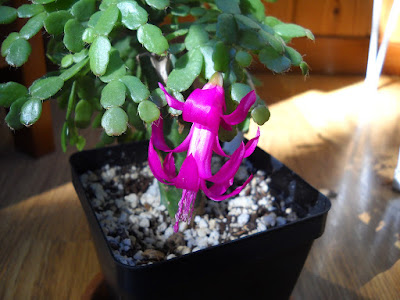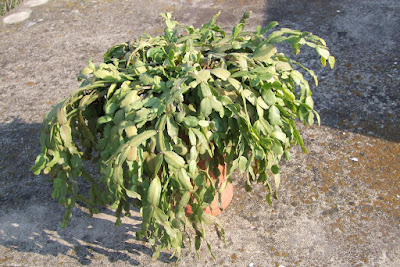Schlumbergera russelliana occurs only in a small area of the coastal mountains of south-east Brazil, in the state of Rio de Janeiro, located in the southernmost part of the tropics. It is found growing on the stems of trees and supposedly occasionally on the ground but these may have been plants that had fallen from the trees at altitudes of 1400-2100 metres above sea level.
Schlumbergera russelliana also called as Epiphyllum russellianum, Cereus russellianus, Phyllocactus russellianus, Schlumbergera epiphylloides, is a species of the genus Schlumbergera. This species was described by Britton & Rose in 1913.
IDENTIFY SCHLUMBERGERA RUSSELLIANA CACTI
Schlumbergera russelliana occurs only in a small area of the coastal mountains of south-east Brazil, in the state of Rio de Janeiro, located in the southernmost part of the tropics. It is found growing on the stems of trees and supposedly occasionally on the ground but these may have been plants that had fallen from the trees at altitudes of 1400-2100 meters above sea level.
It is an epiphyte that has branchlets which do not exceed 1 inch in length and ½ inch in width, whilst the edges are irregularly and faintly notched. The flowers are a little larger than in the older kind, and are not curved, whilst the petals are narrower; their colour is bright rosy-red.
This species flowers rather later in the year, and may be had in blossom so late as the month of May or June. There are several varieties of it which have either larger and darker, or smaller and variously tinted flowers. Both the species will cross with each other, and probably many of the varieties enumerated by nurserymen have been obtained in this way.
The plants are employed with good effect for covering walls, which are first covered with peaty soil by means of wire netting, and then cuttings are stuck in at intervals of about 1 ft. The effect of a wall of the drooping branches of these plants is attractive even when without their beautiful flowers; but when seen in winter, clothed with hundreds of sparkling blossoms, they present a most beautiful picture.
SCHLUMBERGERA RUSSELLIANA CACTI CARE AND CULTURE
Cultural information should only be used as a guide, and should be to be adapted to suit you. Your physical location; where you grow your plants, how much time you have to devote to their care, and many other factors, will need to be taken into account. Only then can you decide on the cultural methods that best suit you and your plants.
Light and exposure:
In summer, any position where Schlumbergera russelliana can be kept a little close and moist, and be shaded from bright sunshine, will suit them. Remembering that their habit, when wild, is to grow upon the trunks of trees, where they would be afforded considerable shade by the overhanging branches, we cannot be wrong in shading them from direct sunshine during summer. All through the summer months, the plants should be syringed both morning and evening; but by the end of August they will have completed their growth, and should, therefore, be gradually exposed to sunshine and air.
Temperature:
These cactus need the temperate temperature: in summer 15°C, rising to 24°C with sun heat, night 15°C to 18°C, in winter 10°C to 13°C. The plants are safest when kept dry during the cold, dull weather between September and April.
Soil:
The soil most suitable for these plants is a mixture of peat, loam, and sand, unless a light and fibrous loam be obtainable, which is, perhaps, the best of all soils for these plants, requiring only the addition of a little rotted manure or leaf-mould, silver sand, and some small brick rubble. Leaf mould is sometimes used, but unless really good it is best left out of the soil.
Potting:
The size of pots most suitable is what would be considered small in comparison with other plants. If small pots are used, the head of the plant is apt to overbalance the whole. The pots should be well drained-about one-fifth of their depth filled with drainage. When filling in the soil, press it down firmly, spreading the roots well amongst it, and keeping the base of the plant only an inch or so below the surface.
When grown as standards, Schlumbergera russelliana should be tied to strong wire supports, those with three short, prong-like legs being most desirable, as, owing to the weight of the head of the plant, a single stake is not sufficient to hold the whole firmly.
Repot:
On the arrival of the potting season (April and May), the plants should be examined at the root, and if the roots are found to be in a healthy condition, and the soil sweet, they should be replaced in the same pots to continue in them another year. If the roots are decayed, or the soil has become sour, it should be shaken away from the roots, which must be examined, cutting away all decayed portions, and shortening the longest roots to within a few inches of the base of the plant.
After potting, no water should be given for a few weeks. In fact, if the atmosphere in which the plants are placed be kept a little moist, it will not be necessary to water them till signs of fresh growth are perceived.
Watering:
During their season of growth, the plants require a good supply of moisture, both at the root and overhead; and afterwards a somewhat lengthened period of rest, that is, almost total dryness, accompanied by all the sunlight possible, and generally a somewhat high temperature. The growing season for these plants which require to be kept dry when at rest is from the end of April to the middle of August, and during this time they should be kept moderately moist, but not constantly saturated, which, however, is not likely to occur if the water is not carelessly supplied, and the drainage and soil are perfect.
Propagation:
These cactus may be multiplied from cuttings of the stems, from seeds, and also by means of grafting. From seeds the plants are generally freer in growth than when cuttings are used, although the seedlings are longer in growing into flowering specimens than large cuttings would be.















COMMENTS